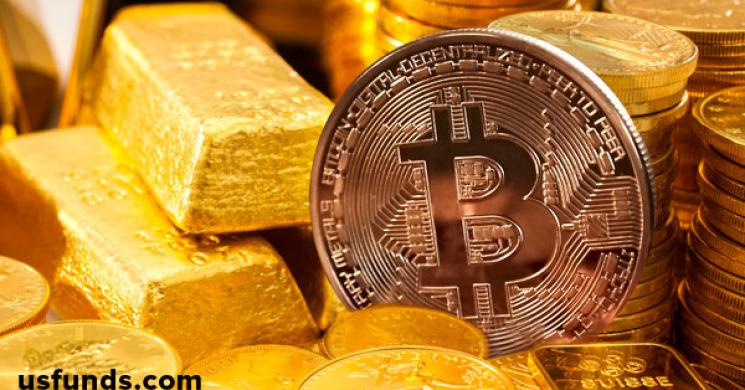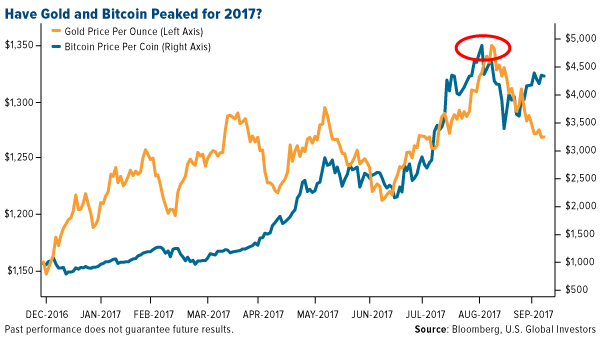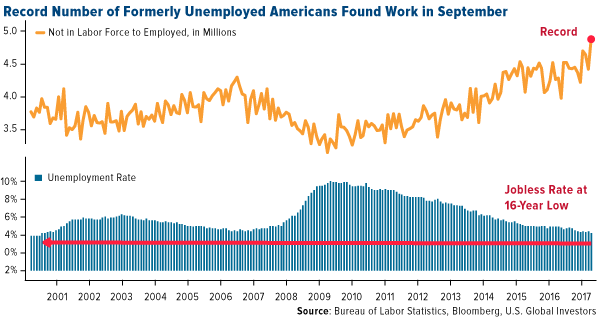
What a week it’s been.
First and foremost, I’d like to acknowledge the horrific mass shooting that occurred in Las Vegas, the deadliest in modern American history. On behalf of everyone at U.S. Global Investors, I extend my sincerest and most heartfelt condolences to the victims and their families.
The memory of the shooting was still fresh in people’s minds during Tuesday’s Hollywood premiere of Blade Runner 2049, which nixed the usual red carpet and other glitz in light of the tragedy. Before the film, producers shared poignant words, saying that in times such as these, the arts are crucial now more than ever.
I had the distinct privilege to attend the premiere. My good friend Frank Giustra, whose production company Thunderbird Entertainment owns a stake in the Blade Runner franchise, was kind enough to invite me along. Despite the somber mood, I thought the film was spectacular. Even if you’re not a fan of the original 1982 film, it’s still worth experiencing in theaters. Hans Zimmer and Benjamin Wallfisch’s synth-heavy score is especially haunting.
CNET recently published an interesting piece examining the accuracy of future tech as depicted in the original Blade Runner, from androids to flying cars to off-world travel read the article here.
Still in the Early Innings of Cryptocurrencies
Speaking of the future, I spoke on the topic of the blockchain this week at the Subscriber Investment Summit in Vancouver. My presentation focused on the future of mining—not just of gold and precious metals but also cryptocurrencies.
Believe it or not, there are upwards of 2,100 digital currencies being traded in the world right now, with a combined market cap of nearly $150 billion, according to Coinranking.com.
Obviously not all of these cryptos will survive. We’re still in the early innings. Last month I compared this exciting new digital world to the earliest days of the dotcom era, and just as there were winners and losers then, so too will there be winners and losers today. Although bitcoin and Ethereum appear to be the frontrunners right now, recall that only 20 years ago AOL and Yahoo! were poised to dominate the internet. How times have changed!
It will be interesting to see which coins emerge as the “Amazon” and “Google” of cryptocurrencies.
For now, Ethereum has some huge backers. The Enterprise Ethereum Alliance (EEA), according to its website, seeks to “learn from and build upon the only smart contract supporting blockchain currently running in real-world production—Ethereum.” The EEA includes several big-name financial and tech firms such as Credit Suisse, Intel, Microsoft and JPMorgan Chase, whose own CEO, Jamie Dimon, knocked cryptos a couple of weeks ago.
To learn more about the blockchain and cryptocurrencies, watch this engaging two-minute video.
Will Bitcoin Replace Gold?
Lately I’ve been seeing more and more headlines asking whether cryptos are “killing” gold. Would the gold price be higher today if massive amounts of money weren’t flowing into bitcoin? Both assets, after all, are sometimes favored as safe havens. They’re decentralized and accepted all over the world, 24 hours a day. Transactions are anonymous. Supply is limited.
But I don’t think for a second that cryptocurrencies will ever replace gold, for a number of reasons. For one, cryptos are strictly forms of currency, whereas gold has many other time-tested applications, from jewelry to dentistry to electronics.
Unlike cryptos, gold doesn’t require electricity to trade. This makes it especially useful in situations such as hurricane-ravished Puerto Rico, where 95 percent of people are reportedly still without power. Right now the island’s economy is cash-only. If you have gold jewelry or coins, they can be converted into cash—all without electricity or WiFi.
Finally, gold remains one of the most liquid assets, traded daily in well-established exchanges all around the globe. Every day, some £13.8 billion, or $18 billion, worth of physical gold are traded in London alone, according to the London Bullion Market Association (LBMA). The cryptocurrency market, although expanding rapidly, is not quite there yet.
I will admit, though, that bitcoin is energizing some investors, especially millennials, in ways that gold might have a hard time doing. The proof is all over the internet. You can find a number of TED Talks on bitcoin, cryptocurrencies and the blockchain, but to my knowledge, none is available on gold investing. YouTube is likewise bursting at the seams with videos on cryptos.
Bitcoin is up 350 percent for the year, Ethereum an unbelievable 3,600 percent. Gold, meanwhile, is up around 10 percent. Producers, as measured by the NYSE Arca Gold Miners Index, have gained 11.5 percent in 2017, 23 percent since its 52-week low in December 2016.
Look Past the Negativity to Find the Good News
The news is filled with negative headlines, and sometimes it’s challenging to stay positive. Take today’s jobs report. It showed that the U.S. lost 33,000 jobs in September, the first month in seven years that this happened. A weak report was expected because of Hurricane Irma, but no one could have guessed the losses would be this deep.
The jobs report wasn’t all bad news, however. For one, the decline is very likely temporary. Beyond that, a record 4.88 million Americans who were previously sitting out of the labor force found work last month. This helped the unemployment rate fall to 4.2 percent, a 16-year low.
There’s more that supports a stronger U.S. economy. As I shared with you this week, the Manufacturing ISM Purchasing Managers’ Index (PMI) rose to a 13-year high in September, indicating rapid expansion in the manufacturing industry. Factory orders were up during the month. Auto sales were up. Oil has stayed in the relatively low $50-a-barrel range, which is good for transportation and industrials, especially airlines. Small-cap stocks, as measured by the Russell 2000 Index, continue to climb above their 50-day and 200-day moving averages as excitement over tax reform intensifies.
These are among the reasons why I remain bullish.
One final note: Speaking on tax reform, Warren Buffett told CNBC this week that he’s waiting to sell assets until he knows the plan will go through. “I would feel kind of silly if I realized $1 billion worth of gains and paid $350 million in tax on it if I just waited a few months and would have paid $250 million,” he said.
It’s a fair comment, and I imagine other like-minded, forward-thinking investors, buyers and sellers will also wait to make huge transactions if they can help it. Tax reform isn’t a done deal, but I think it has a much better chance of being signed into law than a health care overhaul.
Upcoming Event
Later this month I’ll be in Barcelona attending and speaking at the 18th annual LBMA/LPPM Precious Metals Conference, where I’ll be speaking on quant investing. If you’re in the area between October 15 and 17, I’d be thrilled to see you! You can register here.
All opinions expressed and data provided are subject to change without notice. Some of these opinions may not be appropriate to every investor. By clicking the link(s) above, you will be directed to a third-party website(s). U.S. Global Investors does not endorse all information supplied by this/these website(s) and is not responsible for its/their content.
The S&P 500 Stock Index is a widely recognized capitalization-weighted index of 500 common stock prices in U.S. companies. The Russell 2000 Index is a U.S. equity index measuring the performance of the 2,000 smallest companies in the Russell 3000. The Russell 3000 Index consists of the 3,000 largest U.S. companies as determined by total market capitalization. The NYSE Arca Gold Miners Index is a modified market capitalization weighted index comprised of publicly traded companies involved primarily in the mining for gold and silver. The index benchmark value was 500.0 at the close of trading on December 20, 2002.
The ISM manufacturing composite index is a diffusion index calculated from five of the eight sub-components of a monthly survey of purchasing managers at roughly 300 manufacturing firms from 21 industries in all 50 states.
Holdings may change daily. Holdings are reported as of the most recent quarter-end. None of the securities mentioned in the article were held by any accounts managed by U.S. Global Investors as of 6/30/2017.
Read more by Frank Holmes
Read more by MarketSlant Editor



 click to enlarge
click to enlarge click to enlarge
click to enlarge




